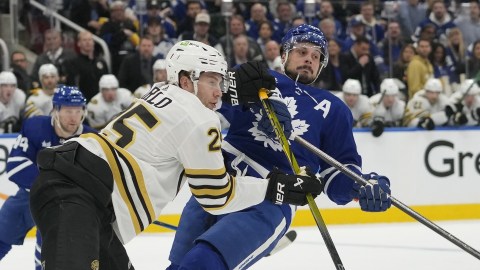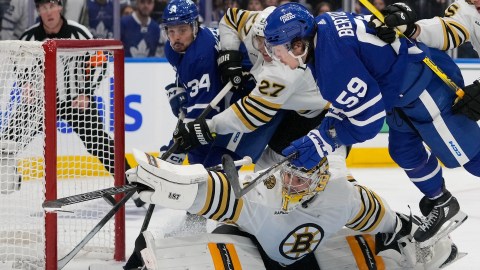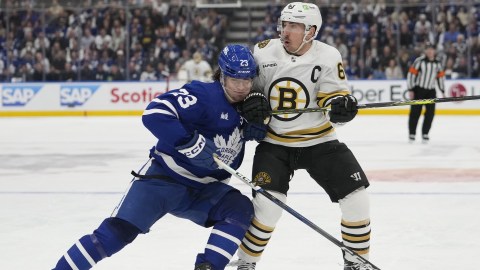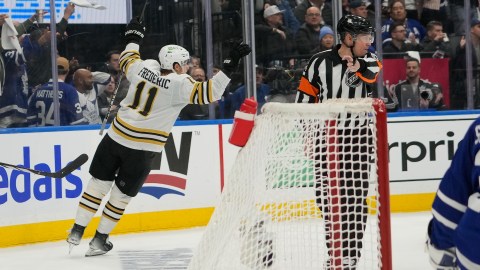After coming up short in their first three attempts this season, the Bruins finally won a shootout when they earned the extra point in Florida on Monday.
It helped keep alive a modest three-game winning streak, which the club will take into Thursday’s game in Atlanta, but it didn’t change my opinion on this blight on the game.
The shootout has been around for six seasons now, when it was instituted after the owners’ lockout ended in 2005. It doesn’t appear to be going away anytime soon.
It remains popular with a strong segment of the sport’s fan base, even if few actually within the game can stomach seeing a game decided in that fashion.
The concept came about because of the notion that fans would no longer accept games without a definitive winner or loser. The fact that the league seemed to survive just fine for 87 years with ties no longer mattered, as fans needed to celebrate a victory or mourn a defeat — regardless of how bogus the mechanism for that resolution.
Ties have long been compared to kissing your sister, and I’ll avoid the obvious joke about wondering how the league could possibly not want to embrace that concept after trying to woo Southern fans for so long. But even accepting the analogy, I’d argue to extend it by noting that shootouts are like kissing a light socket. It might be a thrill for some, but it’s certainly not something I’d fancy.
So now, after 65 minutes of a hard-fought team game, NHL games are decided by an individual matchup in a cheesy skills competition. Only the NHL could take arguably the most exciting moment in sports — the penalty shot — and turn it into an abomination.
The shootout eliminates most of what makes the game great. There is no teamwork, no passing, no checking or physical play of any kind. The stay-at-home defensemen and checking-line forwards are not needed, and the tough guys can forget about ever playing a role in this spectacle, which may actually make them the lucky ones.
The shootout isn’t even conducted under normal playing conditions. After overtime, the path between the faceoff circles down the length of the ice is given a “dry scrape” by the Zamboni, much to the dismay of goalies like Tim Thomas. The NHL’s leader in goals-against average, save percentage and shutouts this season was no match for the dreaded dry scrape earlier this year, when he stopped old friend Phil Kessel‘s deciding goal in a shootout in Toronto, but couldn’t stop himself from sliding back into the net with the puck.
“They scrape the ice [for the shootout], and it’s more slippery than at any other time, even normal fresh ice,” Thomas said after that Dec. 4 game. “It’s just frustrating when you make the save, but you can’t stop your backward slide because of dry scraped ice, which you never face at any other time in hockey.”
The shootout creates plenty of situations you never see at any other time in hockey. Take, for instance, the fact that after 60 minutes, a game worth two points magically now has three at stake. Yes, for all the league’s desire to eliminate ties and have a winner and loser in each game, there is no true loser, with the team that is beaten in overtime or a shootout still getting a point. Consider that the NHL’s answer to a Little League participation trophy, even if most of the players on the team don’t actually get to participate in the shootout.
Thanks to those three-point games, the league’s records are forever skewed. Last year, just seven of the 30 teams finished with losing records, and just eight currently sit under .500 this year. Does anyone find something wrong with a league that has 77 percent of its teams finish the season with winning records?
Those bonus points for shootout wins have already determined several playoff races, most notably last year when Philadelphia beat the Rangers in a shootout in their regular-season finale to secure a postseason berth. Think the Bruins’ playoff run might have ended a little differently if the Flyers hadn’t snuck in thanks to a last-minute skills competition?
And the NHL can’t even deliver on the shootout’s one redeeming value — its potential for entertainment. While it’s an atrocious way to decide a game, a series of breakaways can be fun to watch. That is if creativity were actually encouraged. Instead, when someone like Edmonton rookie Linus Omark tries a spin-o-rama like he did against the Lightning earlier this month, he gets chastised for not “respecting the game.”
Where was that respect for the game when this awful gimmick was installed?
Do you think the shootout is horrible way to decide an NHL game? Share your thoughts below.



